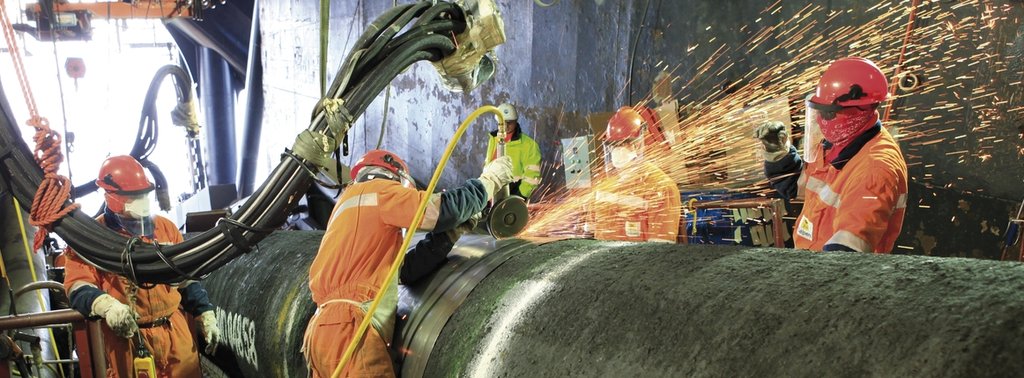From Pipes to Pipeline
The Nord Stream Pipeline system is a major feat of engineering, which involved complex logistics, along with suppliers and contractors from all over the world. The project consists of two pipelines running almost parallel to one another through the Baltic Sea.
Only after design and route of the pipelines was set, and with environmental and construction related permits issued, was everything in place to begin building the pipelines.
In April 2010, Nord Stream's contractors began constructing the first of its two, 1,224-kilometre natural gas pipelines. This moment was just one of many pieces of the complex construction and logistics puzzle, which included, among other things, having pipes manufactured, concrete coated and in the right place at the right time to keep the construction machine running seamlessly for 30 months.
Tailor-Made Plan for the Baltic Sea
Both lines of the Nord Stream Pipeline system were laid in three sections. The three sections have different wall thicknesses following the direction of the gas flow. Gas pressure reduces as it makes its way through the pipelines. Therefore, the walls are thickest at the start of the pipelines at Portovaya Bay, Russia, and thinnest at the landing point at Greifswald, Germany.
Each of the pipelines is made up of about 100,000 pipes. Along the pipeline route, five harbour sites supplied concrete-coated pipes on a continuous basis to the lay barges owned and operated by Nord Stream's contractor, Saipem, and its subcontractor, Allseas. In 2010, three vessels were used to complete the pipelines, working at different segments of the route. Through mid-2011, two vessels were used. From mid-2011 through April 2012, Saipem's Castoro Sei worked on Line 2.
Construction of the pipelines was scheduled to minimise environmental impacts. For example, so as not to interfere with critical seal breeding and fish spawning seasons.
Pipe Laying Handled by Three Vessels
Saipem organised three laybarges; two with special requirements, for the construction of pipelines. Saipem's Castoro Dieci, which is designed to work in shallow waters, worked in the Bay of Greifswald, Germany. The Castoro Dieci laid 28 kilometres of each of the twin pipelines, working from June 2010 to October 2010. The Allsea's Solitaire – the biggest pipelay vessel in the world – laid a 342.5-kilometre segment of each of the twin pipelines, starting in September 2010, completing its work in August 2011. With its dynamic positioning system, the Solitaire was the ideal vessel for working in the congested Gulf of Finland. Saipem's Castoro Sei is laying about 70 percent or 853.5 kilometres of each of the two pipelines. It started working in April 2010, and finished work on Line 1 in May 2011. The Castoro Sei began work on Line 2 in June 2011 and finished in April 2012.
How It Was Done
In preparation for pipe laying, the seabed was surveyed with a remotely operated vehicle (ROV) to ensure pipelay safety and to confirm the seabed data gathered during the lengthy route planning phase. Additionally, in some locations along the route, the strategic placement of coarse gravel was necessary to create a stable base on which the pipeline can rest. Gravel was transported and placed by dedicated rock placement vessels to the specific locations where support was required prior to pipe laying. On board the pipelay vessels, the construction cycle is made up of several steps including bevelling, welding, testing and the lowering of the pipeline onto the seabed. There are exact procedures defined for each process to ensure quality and compliance with health and safety regulations. Following the laying process, the pipelines were again monitored underwater by ROV to ensure correct positioning.
After completion of the construction work, the three pipeline segments were flooded with water and pressure tested to ensure mechanical integrity. Then, the pipeline segments were connected by welding them underwater. Once connected, the pipeline was emptied of water, and filled with nitrogen before natural gas was safely introduced. The connection of these three pipeline sections was carried out at the two locations where the design pressure changes. The connecting of the three sections of Line 1 and Line 2 were completed in June 2011 and August 2012 respectively.
With every aspect of logistics and construction coordinated by Nord Stream experts at the company headquarters, the pipelines were built and operational on time and in budget.
Line 1 was completed in June 2011, and gas transport began in mid-November 2011. Construction of Line 2 began in May 2011, and came on stream in October 2012.








